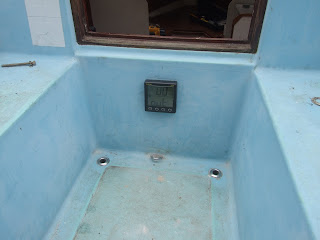The argument for crossing them is that if the yacht is healed over enough, water can enter the cockpit. Looking at it it seems unlikely to be a problem on a Hurley 20. If over that far I would expect the seacocks to be floating clear of the water. I chose to go straight down as it leaves me with access to the under cockpit area which is where I ntend to store my battery and the floor, seat and paddles for my dinghy.Once I am comfortable with the way she sails I shall sheet in tight, get her leaning right over and see if she ships any water through the leeward scupper. blimey, that almost sounds like pirate talk. P~} Aharghh
 |
| Scuppers and NASA duet display fitted. |
 |
| Seacocks fully installed and NASA duet paddle wheel fitted. |
 |
| Position of Seacock skin fitting and Paddle wheel further forward. |
Drilling the hole for the paddle wheel was a bit nervy. It's one of those jobs that you keep looking at and not wanting to start. I positioned it deep in the bilge as that has the best access for maintenence and is also the most ideal place on the outside of the hull. It needs GRP bonding but I shall do that while I'm fitting the rib.
I've also done a load more varnishing, boy I'm glad I haven't got a wooden boat. They look fantastic but I don't believe you would ever get to sail them.
Nice stuff... I'm going to get Pap a depth meter at some point in time, but if I do, for the reasons you describe I'm going to go for a through hull transducer...!
ReplyDeleteStill not sure about those bilge drains - I'm aware of the straight versus crossed discussion but I thought the exit had to be above the waterline??